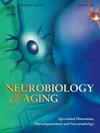认知储备的神经实现:对衰老过程中集合切换的纵向 fMRI 研究的启示
IF 3.7
3区 医学
Q2 GERIATRICS & GERONTOLOGY
引用次数: 0
摘要
衰老往往伴随着大脑结构和执行功能的变化,特别是在涉及认知灵活性的任务中,如任务转换。然而,认知障碍程度的巨大个体差异表明,有些人比其他人能更有效地应对大脑的变化,这表明他们具有较高的认知储备(CR)。本研究通过研究任务相关的大脑激活、大脑结构变化以及在执行任务切换范式(包括单一和双重条件)中认知表现的变化之间的纵向关系,确定了认知储备的神经基础。52名老年人接受了基线评估和五年后的随访。使用弹性网回归分析了与任务切换表现相关的大脑结构变化。与任务相关的大脑功能激活采用顺序趋势典型变异分析(OrT CVA)进行测量,捕捉从单一条件到双重条件的激活增加模式。与任务相关的差异表达得分(dOrT)被计算为基线时单一和双重条件下模式表达得分的差异。线性回归模型测试了 dOrT 是否会调节大脑变化对五年内转换成本变化的影响。结果显示,大脑结构变化和 dOrT 激活对转换成本变化的影响存在明显的交互作用,这表明任务相关激活具有调节作用。较高的dOrT可以缓冲大脑结构衰退对转换成本的影响,使老年人能够更好地应对与年龄相关的大脑结构变化,保持认知灵活性。这些发现表明,这些与任务相关的激活模式代表了 CR 的神经基础。本文章由计算机程序翻译,如有差异,请以英文原文为准。
A neural implementation of cognitive reserve: Insights from a longitudinal fMRI study of set-switching in aging
Aging is often accompanied by changes in brain structure and executive functions, particularly in tasks involving cognitive flexibility, such as task-switching. However, substantial individual differences in the degree of cognitive impairment indicate that some individuals can cope with brain changes more effectively than others, suggesting higher cognitive reserve (CR). This study identified a neural basis for CR by examining the longitudinal relationship between task-related brain activation, structural brain changes, and changes in cognitive performance during an executive task-switching paradigm including single and dual conditions. Fifty-two older individuals were assessed at baseline and followed up after five years. Structural brain changes related to task-switching performance were analyzed using elastic net regression. Task-related functional brain activation was measured using ordinal trends canonical variate analysis (OrT CVA), capturing patterns of activation increasing from single to dual conditions. A differential task-related expression score (dOrT) was calculated as the difference in pattern expression scores between single and dual conditions at baseline. A linear regression model tested whether dOrT moderated the impact of brain changes on changes in switch cost over five years. Results showed a significant interaction between changes in brain structure and dOrT activation on switch cost change, indicating a moderation effect of task-related activation. Higher dOrT buffered the impact of brain structural decline on switch costs, enabling older adults to better cope with age-related brain structural changes and preserve cognitive flexibility. These findings suggest that these task-related activation patterns represent a neural basis for CR.
求助全文
通过发布文献求助,成功后即可免费获取论文全文。
去求助
来源期刊

Neurobiology of Aging
医学-老年医学
CiteScore
8.40
自引率
2.40%
发文量
225
审稿时长
67 days
期刊介绍:
Neurobiology of Aging publishes the results of studies in behavior, biochemistry, cell biology, endocrinology, molecular biology, morphology, neurology, neuropathology, pharmacology, physiology and protein chemistry in which the primary emphasis involves mechanisms of nervous system changes with age or diseases associated with age. Reviews and primary research articles are included, occasionally accompanied by open peer commentary. Letters to the Editor and brief communications are also acceptable. Brief reports of highly time-sensitive material are usually treated as rapid communications in which case editorial review is completed within six weeks and publication scheduled for the next available issue.
 求助内容:
求助内容: 应助结果提醒方式:
应助结果提醒方式:


